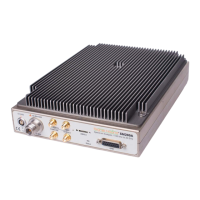The two types of optical fiber used for 10GbE networks are single-mode and multi-mode. Single
mode is commonly used for long distance communications while multi-mode is used for distances
less than 0.3km. Single-mode cables are typically yellow while multi-mode cables are
orange/aqua. Long runs of single mode fiber can have increase data reliability issues causing
increased disconnection issues with your Signal Hound device. If you experience this, we
recommend moving to a higher range module.
Figure 4: Multi-mode fiber cable with two SFP+ SR modules, one attached and one not.
The networked SM device has an SFP+ interface on the front panel. A cable will be connected
from the device to a PC. The two most common ways to connect a 10GbE SFP+ cable to a PC is
through a PCIE 10GbE network interface card (NIC) or a Thunderbolt 3 to SFP+ adapter. We
provide recommendations for both in this document.

